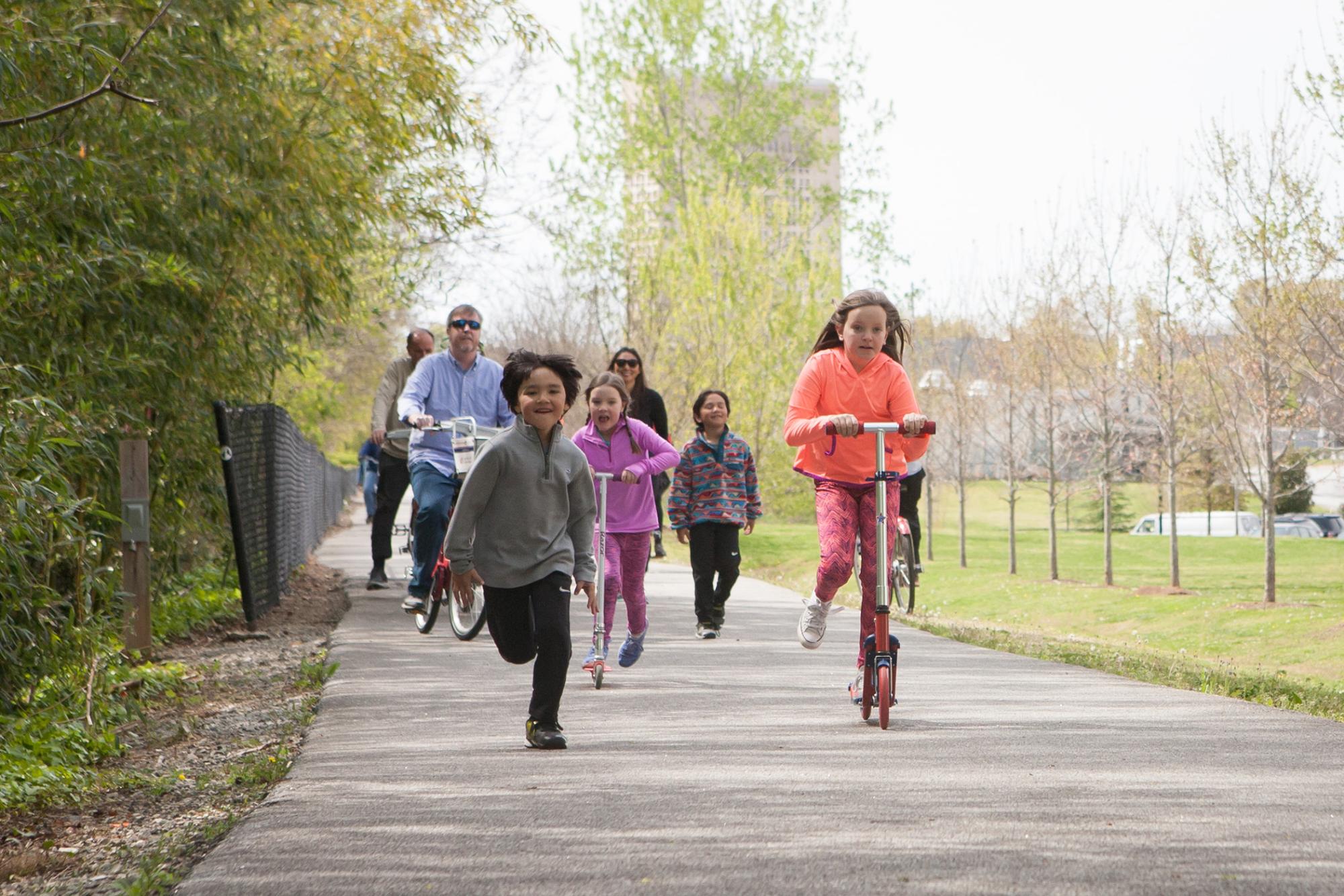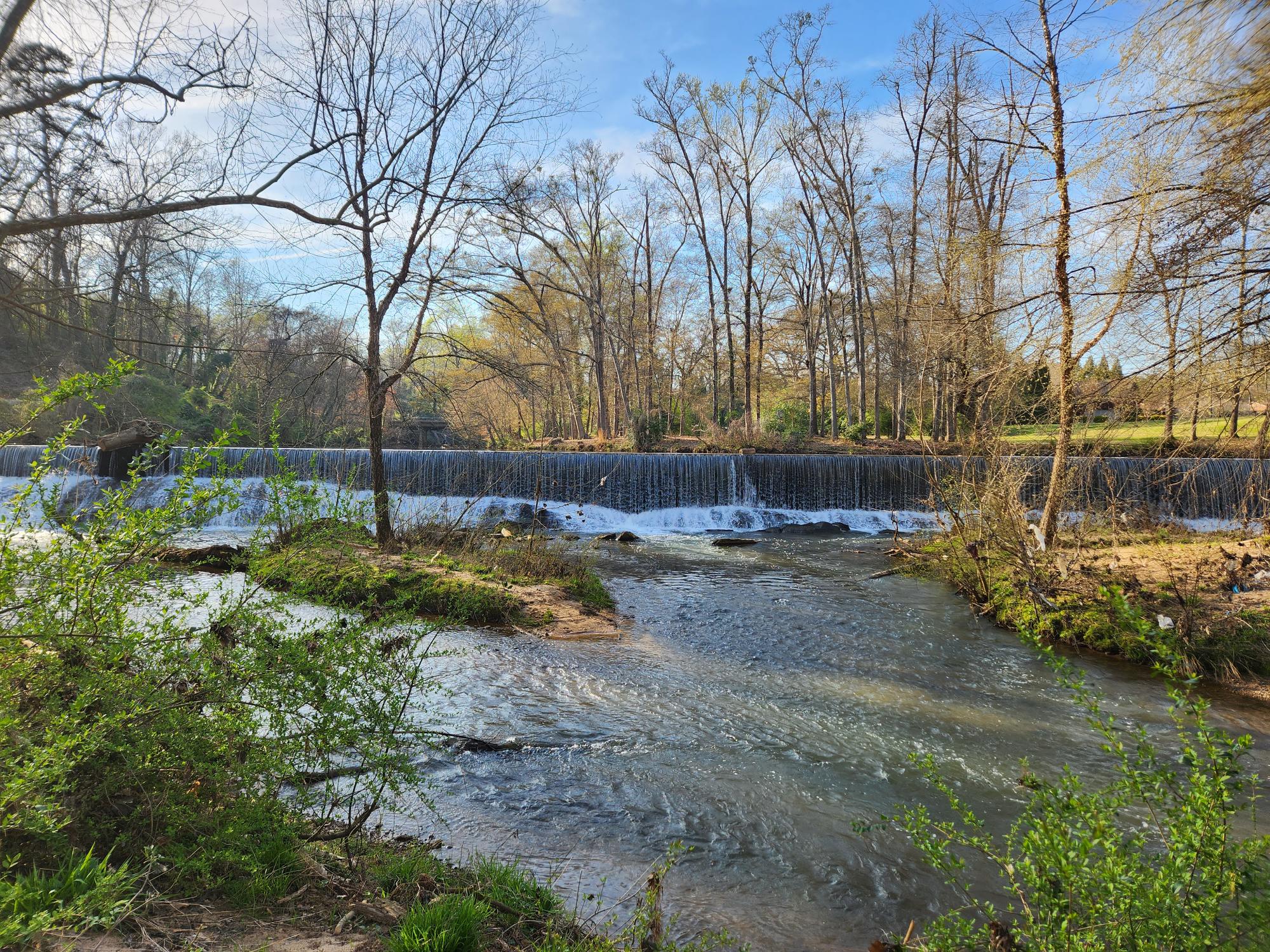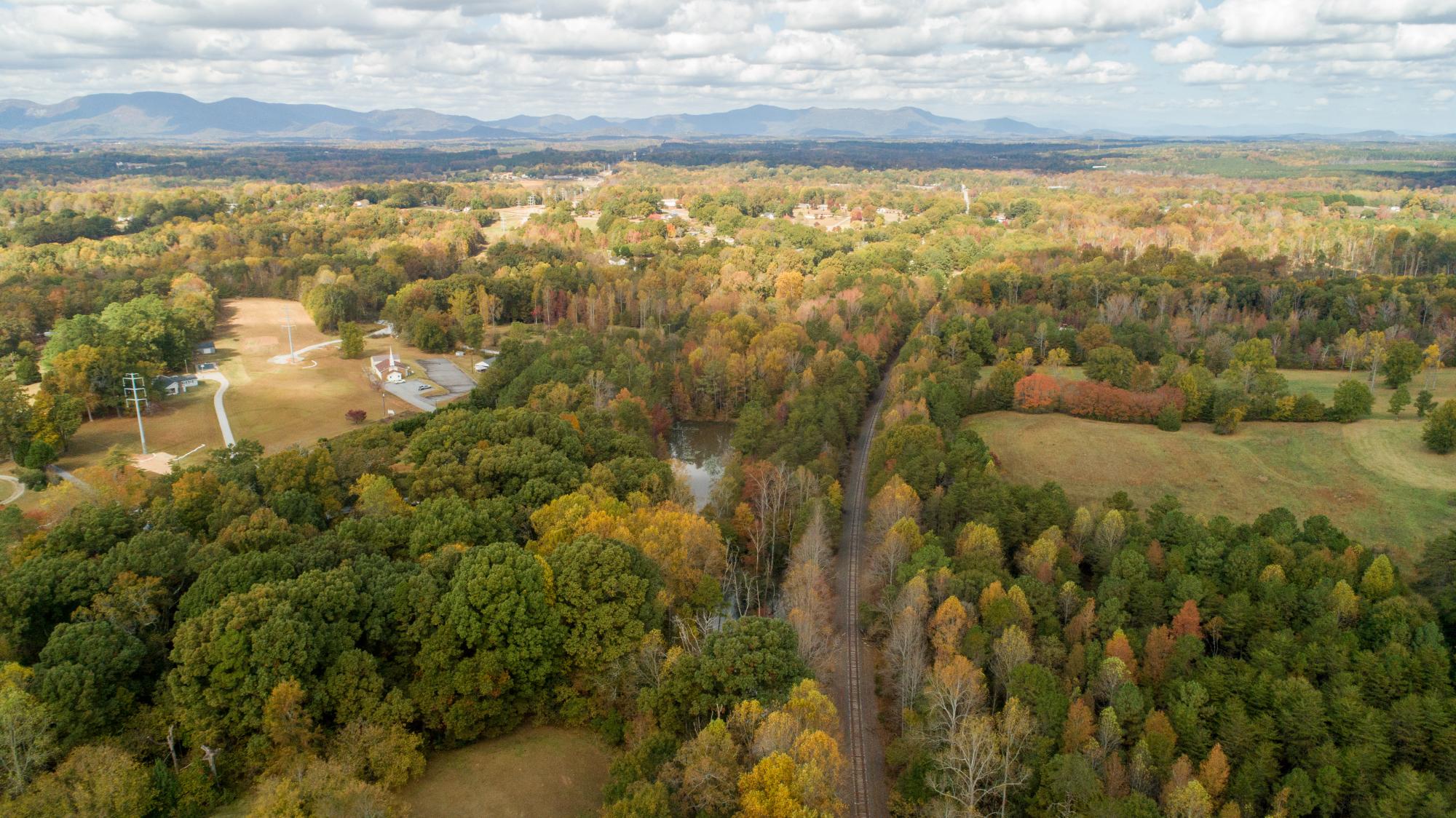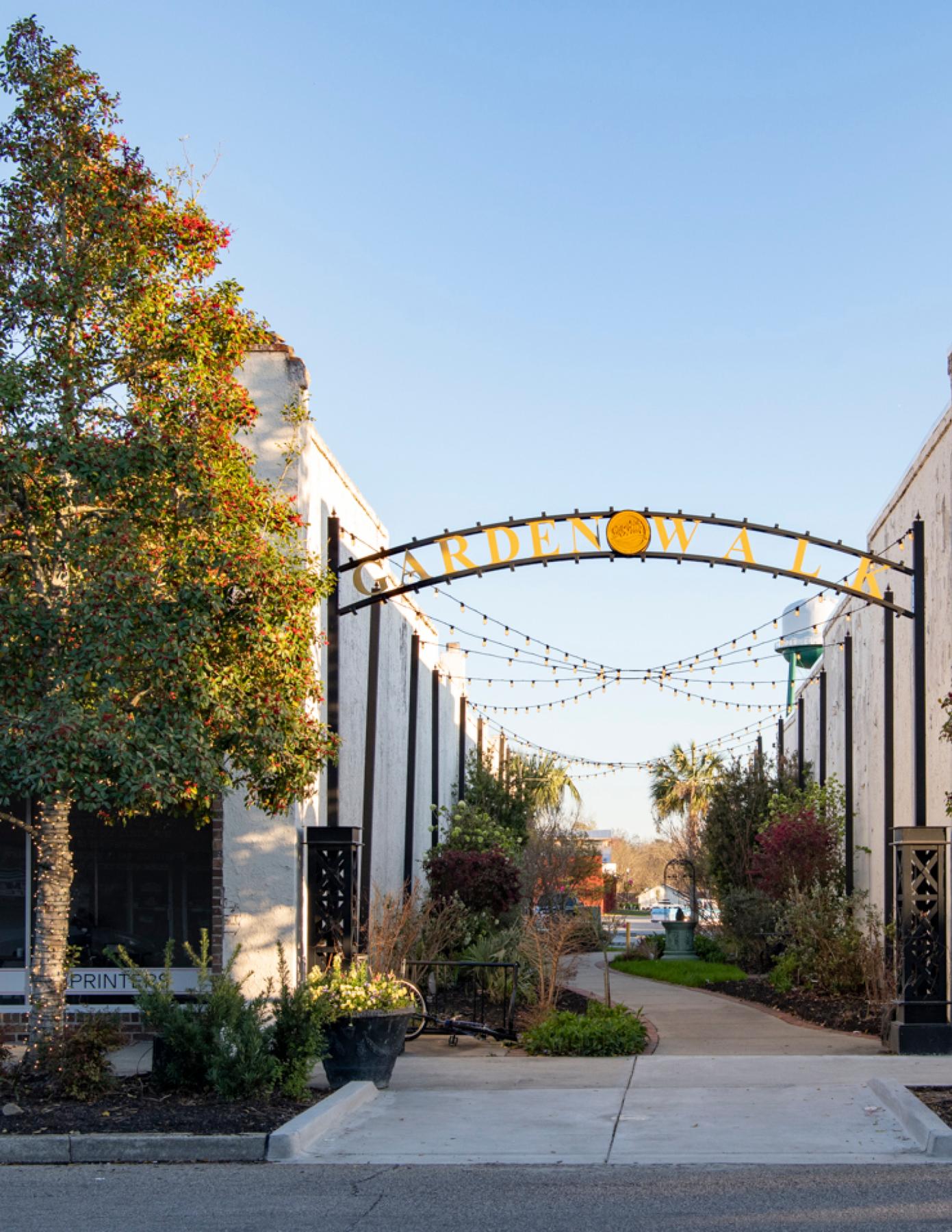
The Mary Black Foundation Rail Trail, nearly 2 miles in length, is a part of the Daniel Morgan Trail System.
Photo: PAL: Play. Advocate. Live Well.
As the executive director of the Spartanburg nonprofit PAL — Play, Advocate, Live Well — Laura Ringo has long-known the importance of recreational trails for economic, health and environmental well-being. Cities around the state are drawn to developing trail networks for all of those benefits.
“Trails provide a free, accessible, low-barrier-to-entry place to be physically active. They also bring a significant economic benefit,” Ringo said. “Developers see trails as a quality-of-life feature for residents, and they are a way for their development to stand above and beyond other developments when they’ve got access to a great connected network … They are also great for the environment. They connect people to nature, and do it in a way that’s not overwhelming for people. They’re great for community connectiveness. People look each other in the eye, they wave and say hello, they connect neighborhoods to each other, to schools.”
Demand for adding new trails has been increasing for many years now, but Ringo said the COVID-19 pandemic boosted demand even further, as trails became safe places to experience nature at a time when many people were confined to their homes.
“We’ve seen our trail use skyrocket since then, and we’re certainly not alone,” she said.
But while cities and other entities agree on the need and importance of trails, it takes time, effort and funding to turn trail dreams into reality.
“It’s a journey. It not an overnight kind of thing,” said Chris Story, Spartanburg city manager.

Running along Lawsons Fork Creek, the River Birch Trail is also part of the Daniel Morgan Trail System.
Photo: PAL: Play. Advocate. Live Well.
In Spartanburg, the catalyst for an expanding trail network is the Mary Black Foundation Rail Trail, a 1.9-mile rail-to-trail conversion from a former Norfolk Southern railroad corridor. The trail, considered a showpiece of Spartanburg’s Daniel Morgan Trail System, opened in 2004 and has drawn economic development and has established a popular recreation outlet.
“We’ve found the trail network has proven to be something people want to be close to. And when people want to be close to something, that creates economic development opportunities,” Story said, adding that at least three apartment developers, along with retail and restaurant developments, have specifically sought to be on the trail network.
“It’s a lifestyle motivation,” Story said. “For example, if you look at it through the lens of an apartment developer, you’re marketing a quality of life. To be able to say, ‘Immediately out your front door you have a recreation amenity,’ is a nice plus. From a developer’s perspective, it’s a high-value proposition.”
And from a city and community perspective, Story said trails are incredibly cost-effective.
“We don’t want to ignore other outdoor recreation elements we offer, but other types of outdoor recreation can’t match the bang for the buck of a trail system in regard to the number of people it can serve, the hours of the day it’s accessible,” he said. “The maintenance costs are easily justifiable in context of how many lives can be positively touched.”
Spartanburg has had a longstanding partnership with the PAL, the nonprofit that has led efforts in planning, fundraising and engagement work to determine the best trail routes, Story said. And partly because of the success of the city’s trail development, legislation was passed offering property owners a state tax credit for donating easements for trail buildouts, he said.
Using that public-private-nonprofit approach to building out a trail system brought more partners to the table and helped smooth the way for what can be a complicated process, Story said. For example, Ringo said a mile and half trail along a creek that opened in Spartanburg in 2023 required obtaining easements from 26 different property owners.
“As a nonprofit, we worked with the city and county on routing and then we approached the property owners,” Ringo said. “It’s a lot less intimidating when a nonprofit comes to talk about an easement on their property, versus somebody from the government.”
It still took five years of work, but all of the property owners eventually said yes.
PAL’s work in Spartanburg with the city and county on an urban trail eventually led to plans for the Saluda Grade Trail, an ambitious 31.5-mile route in South Carolina and North Carolina. As they were negotiating with Norfolk Southern railroad to route the trail under a trestle, the railroad’s real estate arm said it was interested in selling the line that runs from Inman, South Carolina, into North Carolina.
The route is split evenly between the two states, with land acquisition expected to be completed this summer, followed by engineering and design work. Ringo said she hopes the first phase of construction will begin in 2027.

The plan of the Saluda Grade Trail is to use a former rail corridor as a recreational trail to
connect Inman, Campobello and Landrum in South Carolina with mountainous areas in
North Carolina. Photo: Scott Park.
The trail will follow the inactive Saluda Grade rail line, running north from Inman, through Campobello and Landrum before ending in the Zirconia community in North Carolina. Joe Lanahan, Inman’s city administrator, said the trail will offer new life for an asset the city has had for more than 100 years.
“Inman, like a lot of towns in South Carolina, exists for two reasons — agriculture and textiles. Spartanburg County at one time produced more peaches than the entire state of Georgia and Inman was proud to have 12 different packing sheds for peaches along with Inman Mills. The train is what made both of those things possible,” Lanahan said. “However, for the past 35-plus years that mode of transportation for those industries has not been in use. Peach farms closed and textiles shifted to moving things by truck.”
The train line hasn’t been used for nearly 15 years, but it still bisects the city.
“Seeing it sitting there doing nothing to help stimulate economic development and health and wellness was very disappointing,” he said. “So it was very exciting three and a half years ago when it became a conversation about a trail, and two years ago it became actual money from the State House,” he said.
Lanahan said he is hopeful in the next two to three years the city will be able “to get asphalt down and get folks walking.”
In anticipation, the city’s master plan from three years ago identified parking areas for the trail and ways to help with downtown traffic. The city also is engaging with the community that will be affected by the trail, and working to be a good clearinghouse for information.
“The Number 1 thing is education. You need to get ahead of the questions that are going to come with this,” Lanahan said. “If your grandfather bought that farm 85 years ago and the train has been in your backyard all that time, you deserve and should be able to understand what the change in use is going to mean to your piece of property. Everything from when the trail is going to be open, how are we going to make it secure, what does trash pickup look like?”

Conway’s downtown Garden Walk provides an inviting connection between Third Avenue
and Scarborough Alley. Photo: City of Conway.
In Conway, the city has been purchasing property along its river and swamplands to keep it from being developed and to mitigate flooding. As an added benefit, it provides an opportunity for an extensive recreational trail network.
“What’s awesome about those properties is how beautiful they are, and how inaccessible they are,” said Adam Emrick, Conway’s city administrator. “By being able to put trails through these spaces, not only do we make connections with areas we weren’t able to make connections with before, but we’re able to open up these pristine, beautiful areas to the public.”
The trails also allow the city to better tell its story.
“We don’t want to be just that city that is close to Myrtle Beach. We want to be known for the ecological beauty we have,” Emrick said. “There have been spots where we’ve stood and looked over the Waccamaw River and said ‘This is the story we need to tell.’ And by opening up these areas with trails and boardwalks, that’s going to be what tells that tale.”
The city has a growing trail network, and a recent expansion to its Riverwalk offers an even better connection to the city’s thriving downtown.
Conway also recently received $2 million from the state to begin engineering work on the Kingston Ferry and Trail project, aimed at helping the city safely get pedestrians and bicyclists across the Waccamaw River.
The city also is in the process of acquiring 800 acres from Santee Cooper near the former location of the Grainger Generating Station. Emrick said he hopes that the 3.5 miles of riverwalk through the property, which will be easily accessible to downtown, could be open in about three years.
“There won’t be anything else like it,” he said. “It’s like having a state park downtown.”
Mary Catherine Hyman, Conway’s deputy city administrator, said the city’s Pathways and Trails Plan, completed in September 2022, created a guide for where the city should prioritize adding trails, while a city ordinance requires that some new developments provide a connection if they are located close to a trail.
“Getting a plan is very important. It helps wrap your hands around it. Then you need to foster relationships with adjacent municipalities, universities, anyone who might be interested,” she said. “Then hire staff that’s passionate about making the community better.”
